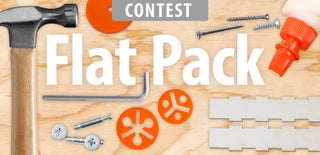Introduction: Easy Photo Reflectors - Large
I recently invested in three things to help improve my Instructables:
- A book on food photography
- A macro lens
- A lighting kit
That didn't leave any room in my budget for the fancy lighting reflectors my book recommended. Inspired by some of the other Instructables on DIY photo reflectors, I decided to make my own. My requirements were simple, they had to be:
- Made from materials already around the house
- Freestanding
- Able to be laid flat for storage
- One soft white
- One shiny
What makes these unique compared to others is their size (they are quite large - 40" x 60"), and the use of gaffer's tape to make a sturdy hinge that requires tape on only one side.
Materials:
- 1 Mylar emergency blanket
- Gaffer's Tape*
- 4 sheets of 20x30 3/16" Foam Board
- 3M Super 77 spray adhesive
*Gaffer's tape is stronger than duct tape, more easily adjusted, and makes for a better hinge in that folding and re-folding it won't wear out it or it's adhesive.
Follow me on Instagram - @therealcoffeedude
Step 1: Soft White
Lay 2 pieces of foam board down so the long edges are next to each other. Check for blemishes. If there are, make sure that the side with the blemish is facing up and on top, so that when finished, it will be on the back.
With the edges even, lay a strip of gaffer's tape along the edge and press down. Stretching it slightly, bring it down and around to take the two pieces of foam board together. Continue tape the edge until you reach the other end. Your soft white reflector is now complete. Repeat this process with the other two pieces of foam board and continue on to the next step to make a shiny version.
Step 2: Shiny Reflector
Take the soft white reflector used in the previous step and lay it flat so the tape hinge is facing down. Be sure to cover your work surface with old cardboard or other such disposable material. The spray adhesive is strong and difficult to get off surfaces without thinner....which would likely take the finish right off of any dining or kitchen table.
Open the emergency blanket and crinkle it up repeated to remove the creases and create lots of small wrinkles. This is to prevent hot spots, or so the other Instructables tell me :)
Spray 3M Super 77 generously on the op of the foam board. Allow to set for 15-30 seconds...at this point the adhesive is tacky, but you can still adjust what you stick to it. Lay the blanket on top of the foam board and press down, working from one side to the next. Don't worry about wrinkles or creases, they should work in our favor. Once the blanket is adhered to the foam board, flip the board over and trim off any excess blanket, leaving a 3-4" border. Fold this border over the back of the board and tape down all the edges with gaffer's tape. We don't want to leave any loose edges to get caught on equipment or lights when in use.

Participated in the
Flat Pack Contest













